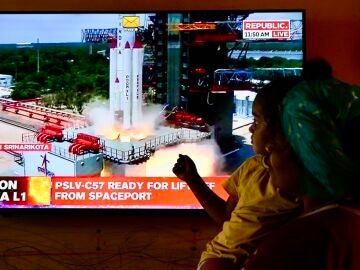
India has successfully launched this Saturday its first space mission destined for the study of the Sun, a launch that represents a new achievement for the space program of the Asian country, which a week ago became the first nation to land on the moon’s south pole.
The takeoff of the Aditya-L1 probe (Sun, in Sanskrit) with the Polar Satellite Launch Vehicle (PSLV) rocket took place at 11:50 am (6:20 am GMT) from the center of Sriharikota, in the southeastern state of Andhra Pradesh.
“Congratulations, Aditya-L1 has been injected into an elliptical orbit…which is very precisely what PSLV was aiming for,” said Indian Space Research Organization (ISRO) chief Sreedhara Panicker Somanath. , from the control center after confirming the success of the takeoff.
As he explained, from now on Aditya-L1 will start his journey, after some maneuvers on the ground he will start his journey to point L1. A very long trip of almost 125 days.
The probe will orbit the Earth for 16 days, and will use that time to progressively gain speed, before heading towards its final destination: the first Lagrange point (L1), a place between the sun and the earth separated by 1.5 million kilometers from our planet.
The mission will take about four months to reach that point, which is barely 1% of the distance that separates both celestial bodies, and which stands out for being gravitationally stable, since the attraction of the Sun and the Earth is in balance, facilitating observation of the star without being affected by eclipses or occultations.
What is the mission?
From there, Aditya-L1 will study the outermost layers of the Sun, the photosphere, the chromosphere and the coronathrough seven payloads that will use electromagnetic and particle detectors and magnetic fields, as reported by the ISRO.
These tools have the objective of “obtaining information that helps understand the issues of coronal heatingthe coronal mass ejection, the activities prior to solar flares and their characteristics, the dynamics of space weather, the study of particle propagation and fields in the interplanetary medium”.
The mass of Aditya-L1 is 1480.7 kilograms and it is expected to remain operational for about five years. Although ISRO has not reported the mission’s budget, local media estimate it amounts to about 4,000 croresequivalent to more than 48 million dollars.
With this mission, India joins a select group of countries that have sent probes to study the Sun, including China, the United States, Japan, or the extinct West Germany (in collaboration with NASA), in addition to the European Space Agency (THAT).
Mission to the Sun and the Moon: two very close milestones
The Prime Minister of India, Narendra Modi, has congratulated ISRO scientists via Twitter “for the successful launch of India’s first solar mission” and recalled that this new journey joins the recent success of the country with its Chandrayaan-3 mission to the Moon.
The launch of Aditya-L1 comes ten days after the historic landing of an Indian probe on the unexplored south pole of the Moon, as part of the Chandrayaan-3 mission of ISRO, which made the Asian country the first nation to reach the southernmost area of the terrestrial satellite.
Source: Lasexta
Ricardo is a renowned author and journalist, known for his exceptional writing on top-news stories. He currently works as a writer at the 247 News Agency, where he is known for his ability to deliver breaking news and insightful analysis on the most pressing issues of the day.











